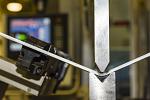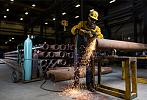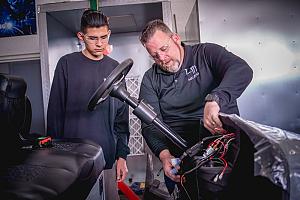Senior Editor
- FMA
- The Fabricator
- FABTECH
- Canadian Metalworking
Categories
- Additive Manufacturing
- Aluminum Welding
- Arc Welding
- Assembly and Joining
- Automation and Robotics
- Bending and Forming
- Consumables
- Cutting and Weld Prep
- Electric Vehicles
- En Español
- Finishing
- Hydroforming
- Laser Cutting
- Laser Welding
- Machining
- Manufacturing Software
- Materials Handling
- Metals/Materials
- Oxyfuel Cutting
- Plasma Cutting
- Power Tools
- Punching and Other Holemaking
- Roll Forming
- Safety
- Sawing
- Shearing
- Shop Management
- Testing and Measuring
- Tube and Pipe Fabrication
- Tube and Pipe Production
- Waterjet Cutting
Industry Directory
Webcasts
Podcasts
FAB 40
Advertise
Subscribe
Account Login
Search
Material handling automation moves forward at MODEX
Predictability trumps speed with automated manufacturing technology
- By Tim Heston
- May 3, 2024
In March, when I tread the MODEX show floor in Atlanta, a humanoid robot paused, put down its payload, then waved. I had just met a bipedal mobile manipulation robot (MMR), a mute C-3PO with legs that articulate the opposite way. The friendly robots worked steadily and unceasingly at a booth occupied by Agility Robotics, a company launched in 2015 from the robotics research out of Oregon State University.
This sight complemented myriad other forms of automation I witnessed at the show: warehousing systems, automated guided vehicles, autonomous mobile robots, and of course the traditional articulated arm robot and (especially) cobot. Automation is everywhere, and it’s changing how people think at companies throughout the manufacturing supply chain.
“We need to consider the ‘why’ behind [our technology investments]. Everything you see around you at this show, that’s the ‘what.’ Often, people say they have a labor problem, and they jump instantly to robots, but no one takes the time to study the implications of why they’re [automating]. The ‘why’ component drives the solution … We need to define what success means.”
That was Shawn O’Farrell, automation technical lead at DISHER, who gave a poignant talk on automation at the show. Quoting ideas popularized by Simon Sinek, O’Farrell said that the “why” should involve holistic thinking, not just to avoid an obvious issue, like dealing with high turnover or people who don’t show up to work.
His comment brought to mind a metal fabrication industry metric I learned about back in February. During a breakout session at the Fabricators and Manufacturers Association (FMA) Annual Meeting in Clearwater, Fla., Steve Zerio of Triumph Partners pointed to this jagged peak-and-valley chart that told the story of sales growth in custom metal fabrication. It essentially depicted the roller coaster custom metal fabricators have endured over the past few years: 9% in 2013, -4% in 2017, 14% in 2019, then down to -14% during the pandemic years before skyrocketing again to 35%.
The numbers came from FMA’s annual “Financial Ratios and Operational Benchmarking Survey,” an annual report that dives deep into the custom metal fabrication business. The tumultuousness in sales growth and other metrics has become the norm as supply chains are reimagined and rearranged. Reshoring is real, but so is reglobalization. As Ephrat Livni reported recently in the New York Times, the term means “the constantly shifting circumstances and relationships in global trade.”
Sometimes it makes sense to reshore, sometimes it doesn’t, and the supply chain puzzle pieces are always on the move. Metal fabricators need to react in concert with a complex web of other suppliers. Perhaps more than anything else, this fact has driven the industry’s relentless push toward automation. To reflect on O’Farrell’s talk at MODEX, constantly changing demand is the “why” behind a lot of technology investments. The industry needs to scale up and down quickly, and the labor just isn’t available to make it happen in an efficient and safe way.
Besides, who wants to make a living lifting heavy parts all day, or spend a career performing monotonous tasks? Automation gives people options. They can focus on a craft that really can’t be automated; they can cross-train; they can learn to program and manage automation; or they can do all of the above. Such options make a metal fabrication career all the more compelling.
Of course, the physical automation is just half the picture. Data governs the other half. “As long as we understand what the production plans are, and we can see the information, we can work with suppliers to ensure they start to build and shop the right products to meet production demand.” That was Michael Jones, director of business development of Hydrian, a MODEX exhibitor that works with distributors and manufacturers to optimize inventory levels, with both software modeling and consulting.
“We really want to understand supplier SKU performance. How often are they late? How much money are you really saving? How does an overseas supplier affect lead times?” The idea isn’t to beat suppliers up by demanding shorter and shorter lead times. The goal, Jones said, is to build realistic lead times into planning. At the same time, though, such scrutiny does shine a spotlight on supply chain performance. Speed matters, but predictability matters even more. A fabricator that nearly always meets the promises it makes stands above a fabricator that promises the world and yet underdelivers.
This came to mind while I was watching those humanoid robots from Agility at MODEX. As of September 2023, two customers—an Amazon facility in Seattle and a GXO facility in Flowery Branch, Ga.—had initiated MMR pilot programs. The robots have scanners to detect where they are and the obstacles around (and below) them. They can walk on uneven terrain, and they’re all connected to a software system that enables them to, given the right instructions, operate autonomously.
They weren’t particularly fast. In fact, they reminded me a bit of the part removal automation from a laser or punch—constant, steady, and, should a demand spike occur, able to keep going and going in a predicable way. That predictability helps any company, from Amazon to the smallest fab shop, smoothly navigate ever-changing demand.
subscribe now

The Fabricator is North America's leading magazine for the metal forming and fabricating industry. The magazine delivers the news, technical articles, and case histories that enable fabricators to do their jobs more efficiently. The Fabricator has served the industry since 1970.
start your free subscriptionAbout the Author

Tim Heston
2135 Point Blvd
Elgin, IL 60123
815-381-1314
Tim Heston, The Fabricator's senior editor, has covered the metal fabrication industry since 1998, starting his career at the American Welding Society's Welding Journal. Since then he has covered the full range of metal fabrication processes, from stamping, bending, and cutting to grinding and polishing. He joined The Fabricator's staff in October 2007.
Related Companies
- Stay connected from anywhere

Easily access valuable industry resources now with full access to the digital edition of The Fabricator.

Easily access valuable industry resources now with full access to the digital edition of The Welder.

Easily access valuable industry resources now with full access to the digital edition of The Tube and Pipe Journal.
- Podcasting
- Podcast:
- The Fabricator Podcast
- Published:
- 05/14/2024
- Running Time:
- 62:12
Cameron Adams of Laser Precision, a contract metal fabricator in the Chicago area, joins the podcast to talk...
- Trending Articles
Why employee-owned companies make sense in manufacturing

What software automation means for custom fabrication

Nucor’s weekly steel price announcement continues to rattle markets

Press brakes, panel benders, and flat blank calculations

Educating, rather than just training, tomorrow's workforce

- Industry Events
Laser Welding Certificate Course
- May 7 - August 6, 2024
- Farmington Hills, IL
World-Class Roll Forming Workshop
- June 5 - 6, 2024
- Louisville, KY
Advanced Laser Application Workshop
- June 25 - 27, 2024
- Novi, MI
Precision Press Brake Certificate Course
- July 31 - August 1, 2024
- Elgin,



























